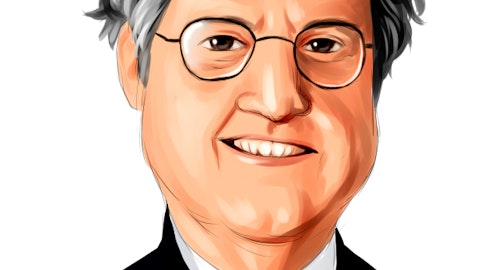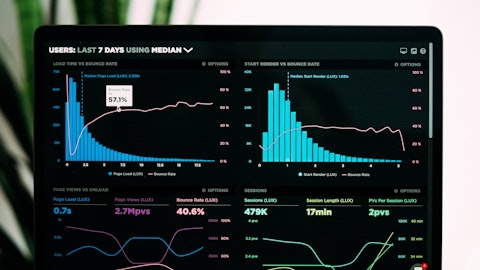ADT Inc. (NYSE:ADT) Q4 2022 Earnings Call Transcript February 28, 2023
Operator: Greetings, and welcome to the ADT Fourth Quarter and Full Year 2022 Earnings Conference Call. At this time, all participants are in a listen-only mode. A brief question-and-answer session will follow the formal presentation. As a reminder, this conference is being recorded. It is now my pleasure to introduce your host Elizabeth Landers, Senior Director of Investor Relations. Thank you. You may begin.
Elizabeth Landers: Thanks, operator, and good morning, everyone. We appreciate you joining ADT’s Fourth Quarter and Full Year 2022 Earnings Call. Speaking on today’s call will be ADT’s President and CEO, James DeVries; and our EVP and CFO, Ken Porpora. After the prepared remarks, we’ll take analyst questions. Also joining us for Q&A are Don Young, EVP and Chief Operating Officer; and Jill Greer, SVP of Finance and Investor Relations. Earlier this morning, we issued a press release and slide presentation of our financial results. These materials are available on our website at investor.adt.com. Before we start, I do need to mention that, today’s remarks include forward-looking statements that represent our beliefs or expectations about future events.
These forward-looking statements are subject to risks and uncertainties that could cause actual results to differ materially. Some of the factors that may cause differences are described in our SEC filings. We’ll also discuss non-GAAP financial measures on the call. The most directly comparable GAAP measures, along with a reconciliation of those measures are available on our website at investor.adt.com. And with that, I’ll turn the call over to Jim.
James DeVries: Thank you, Elizabeth. Good morning. Thank you, operator, and thank you to everyone for joining us on our earnings call today. ADT released our fourth quarter and full year results this morning, 2022 was a very strong year as we delivered our financial commitments, strengthened our foundation and advance the transformation of our business from a traditional security company, towards an innovative business poised to accelerate growth in new markets. I’d like to begin by sharing some of our growth highlights. For the full year, we grew revenues, earnings and cash flows. Our total revenue was up 21% to $6.4 billion, generating adjusted net income of $218 million, or $0.24 per diluted share. We also posted improved adjusted EBITDA up 11% year-over-year, and over $550 million of adjusted free cash flow, up 20% year-over-year.
Importantly, we met our commitments to our shareholders, delivering total revenue and adjusted EBITDA at or above the top end of our full year guidance, and met our adjusted free cash flow guidance. As part of growing the business, we’ve also focused on diversifying our revenue streams. To this end, during the last several years, we’ve expanded our commercial business as well as acquired residential solar business. These actions resulted in meaningful TAM expansion in both of these fast-growing markets. Our commercial revenues grew 10% for the full year, and our solar business ended just under $800 million in revenues for 2022. For yet another consecutive quarter, our recurring monthly revenue balance or RMR was at a record level, and we maintained our record revenue payback of 2.1 years.
Customer retention also continued to improve, with gross attrition at an all-time low of 12.5%. In addition, underscored by a record revenue payback level, capital efficiency is improving our free cash generation allowing us to invest in innovation and improve our balance sheet. We’ve now reduced our leverage ratio to below four. We delivered these impressive results while simultaneously driving transformation. We’re effectively managing our business, as we’ve transitioned from the traditional owning the alarm company toward a broader vision of owning the entire smart and secure ecosystem with our expanded commercial solar and mobile offerings ADT is the single provider that can meet our customers’ needs at home, at work and on the go. I’d like to highlight specifically the strategies we’re implementing to address our customers’ needs in the home.
With the launch of our ADT+ platform and next-gen hardware expected this year, we are putting all the pieces in place to expand the customize choices for our customers. Our vision, includes, customers choosing which distribution channel best meets their individual needs including choosing not only our signature in-home options, but expanding other customer alternatives and choices virtually assisted online and retail options. We’ll also be customizing our pricing and packages offering customers options that include attractive entry price points with greater contract flexibility. This allows our customers to determine the right combination of personalized options that will provide them with the best value for their needs. Another choice customers will have is customizing installation and service.
We’re leveraging advanced technology to give customers more virtual options for sales, service and installation. To-date our virtual assistance initiatives have been a huge success as well as valued alternative to our customers allowing ADT to deliver higher quality services at a lower cost. ADT partnerships also continue to play an important role in our transformation and two of our most significant partnerships are with Google and State Farm. In distinctive yet complementary ways, both of these partnerships are expected to broaden our distribution reach and our customer offerings, giving customers even more reasons to choose ADT. Google Nest products have proven to be a great addition to our ADT offerings. After nearly a year-end market our attachment rates for video doorbells have doubled, and we’re now selling approximately 30% more cameras per home with the Google Nest product.
We expect to see more uplift in device sales, as we move through this year. We’ve just rolled out the integrated ADT+ app experience for our new self-install products which integrates the Google Nest product set. We launched this just a few weeks ago, an exciting accomplishment and we expect to do the same for our Pro Install products later this year. To support this shift, we’ve recently launched a new advertising campaign to increase the continued awareness and differentiation of our new capabilities further igniting customer demand. The success of our Google Nest products is also driving substantial increases in our installation revenue per subscriber, which in-turn is improving our SAC efficiency. The Google Nest product addition simply said provides us with a higher-quality customer offering.
Complementing this success is our State Farm partnership with an existing customer base of approximately 14 million homeowners State Farm has the potential to provide a significant increase to ADT’s overall reach. The partnership will also facilitate State Farm customers obtaining access to ADT’s best-in-class protection. Together, ADT and State Farm are revolutionizing the value proposition for home insurance policyholders by leveraging smart home technology to detect and mitigate losses related to water, fire, intrusion and other homeowner risks. We expect to begin launching in a limited number of states, our first exclusive State Farm offer during the first half of this year and anticipate growth from this partnership to be reflected into 2024.
We had many things to be proud about throughout 2022 and during the fourth quarter. And as we begin this year, we’re poised to navigate a challenging economic environment. While the macro environment remains uncertain, our business model has consistently demonstrated it is recession-resilient, with approximately 70% of our total revenue coming from recurring revenue streams. Home improvement spending as a percent of disposable income remains at record levels translating into stronger demand for our products. Within our Consumer and Small Business segment or CSB, I’m really pleased with the drivers we’re seeing for increased customer stickiness, more devices per home, higher upfront customer investments, remarkable credit score mix and higher video take rates, all bode well for our future.
While the demand environment appears to be steady, we’re still ensuring that if we experience any material changes in demand, we’re staying nimble and able to move quickly. To that end, we’re streamlining our cost structure and our CSB segment. This mirrors similar actions made last year in both our commercial and solar segments, this streamlining will allow us to better focus our investments in growth and innovation while improving our speed to market and ensuring that more of our revenue growth drops to the bottom line. We’re also navigating the challenging interest rate environment we face. In the consumer business, higher rates affect attrition and are actually a net positive on this important metric, given fewer relocations for existing customers.
Higher interest rates also influenced our solar business, where most purchases are financed through long-term, low interest loans. This impacts both sales, as customers are seeing higher rates year-over-year and also expenses as any cost to buy down the rate gets passed-through to us. And of course, the biggest potential impact could be on our cash interest. And fortunately, most of our variable rate debt is hedged. This has underscored our intent, which we shared at our Investor Day last year to actively reduce our debt levels. Our net leverage ratio at the end of 2022 was 3.9, a meaningful improvement from 4.4 just a year ago. Our goal is to get that under three times by the end of 2025, consistent with our long-term financial plan. The final item we are focused on is the performance in our solar business.
We’ve analyzed the business from top to bottom, instituting changes to improve the overall operation, customer experience and financial outcomes. As part of this effort, we appointed longtime ADT veteran, Jamie Haenggi, as our new Executive Vice President of Solar, leading this growing segment. While these changes have improved results in ADT Solar, we know we still have work ahead of us to drive and sustain the level of performance, we expect this segment of our business to deliver. So in closing, we’re optimistic for 2023. We have a recession resilient business model and a plan to mitigate the challenges, we may face in these uncertain economic times. We have two meaningful consumer growth catalysts and our partnerships with Google and State Farm, and line of sight to growing revenues, earnings and cash flows in the year ahead.
Our commercial business is thriving, and we have action plans in place to capitalize on the growth available to us in the solar market. We have a strong plan and commitment, to meeting both our 2023 objectives and the 2025 goals we laid out at Investor Day, just a year ago. I will now turn the call over to our CFO, Ken Porpora, who will take you through the details of our financial results, including guidance for 2023.
Ken Porpora: Thank you Jim, and thank you everyone for joining our call today. As Jim mentioned, we have delivered on our financial objectives for 2022, and have clear momentum across each of our business segments. I’m excited with these results, delivered by our team. Total company revenue was $1.6 billion for the quarter and $6.4 billion for the full year, up 21% versus prior year including the benefit of our solar acquisition. Excluding solar, our revenue grew approximately 7% in 2022. Our recurring monthly revenue or RMR from our subscriber base grew to $374 million or up 4% year-over-year, a record for the company and a strong reflection of the benefits of our higher average pricing, growth initiatives and improved customer retention.
This stronger revenue translated into higher adjusted EBITDA, which for the full year was $2.45 billion, up 11% versus prior year. Adjusted net income was $92 million or $0.10 per share in the fourth quarter, an improvement from a loss of $25 million last year. For the full year, we delivered adjusted net income of $218 million or $0.24 per share, representing our first full year positive adjusted net income since IPO. Moving to our segment highlights. Our Consumer and Small Business or CSB segment delivered total revenue of $1.1 billion in the fourth quarter. And for the full year, this segment delivered $4.4 billion in revenue, an increase of 6% or $233 million versus last year. This performance was driven primarily by a 5% increase in monitoring and related services revenue, resulting from higher average pricing, subscriber growth and improved customer retention that I referenced earlier.
CSB Adjusted EBITDA increased by $204 million or 10% for the full year, and was driven by the increased revenue combined with cost efficiencies. EBITDA margin in 2022, expanded year-over-year by 200 basis points. Our virtual service program is continuing to drive high levels of customer satisfaction and significant cost savings. Since launch in 2021, we have completed over one million virtual assistance appointments. Nearly, 40% of all service requests in 2022, were satisfied virtually, which drove a reduction in net service cost of 8%, despite year-over-year growth in our subscriber base. Strong demand for the Google Nest products, has been an accelerator for our SAC efficiency and a record revenue payback of 2.1 years. Just a year ago, our revenue payback was 2.3 years.
Our installation revenue, in our direct residential business, exited Q4 over $1,300 per home, up 21% year-over-year. Turning to our Commercial segment. We delivered total revenue of $328 million in the fourth quarter, up 15% versus prior year. And for the full year, the commercial team delivered $1.2 billion in revenue. Our commercial sales and installation revenue was strong in the fourth quarter and we are beginning to turn the backlog from earlier in the year to revenue. Installation backlog remains robust at $420 million, providing a continued pipeline for future revenue and margin. This strong revenue performance drove adjusted EBITDA of $127 million for the year, up 32% with expanded EBITDA margins for both the quarter and full year. I am very pleased with the momentum we have in this segment.
Our Solar segment posted revenue of $200 million in the fourth quarter and $786 million for the full year. As Jim mentioned, we’re taking actions to improve operating margins in our solar business including improvements in scheduling and labor planning, workforce rightsizing and pricing adjustments. We expect these actions to drive improvement in profitability in 2023. Turning our attention to cash flow. Adjusted free cash flow was $269 million in the fourth quarter and $558 million for the full year, in line with our guidance range and up 20% versus prior year. Strong EBITDA growth in our CSB segment and improved capital efficiency helped us overcome a shortfall in our Solar segment. Our improved efficiency enabled us to grow our ending RMR by 4% with a 12% year-over-year decline in subscriber acquisition spend, which you can see in our record 2.1 year revenue payback.
We have also been focused on strengthening our balance sheet. Our actions this year have driven our leverage below four times, an important step in our path to reduce that ratio at/or below three times by the end of 2025. Our net leverage ratio now stands at 3.9 times, down from 4.4 times at year-end 2021. We expect to reduce our net debt balance by more than $200 million this year. As part of this effort, we have given notice to holders that we will repay the upcoming 700 million 2023 maturity with the 600 million senior secured Term Loan A facility we closed on last year along with cash on hand. Following this repayment, we have no meaningful maturities left this year and will turn our focus to addressing the $750 million due next year with manageable debt maturities, limited variable rate exposure and our strong recurring revenue mix, we are well-positioned against rising interest rates.
And finally turning to guidance. We expect momentum in all segments of our business to overcome macro trends and result in growth in revenue, earnings and cash flows in 2023. More specifically, we expect total revenue of $6.6 billion to $6.85 billion, representing growth of approximately 5% at the midpoint. With margin expansion in all three segments, this top line growth translates to adjusted EBITDA of $2.525 billion to $2.625 billion also representing growth of approximately 5% at the midpoint and in a newly added guidance metric we are also forecasting adjusted earnings per share of $0.30 to $0.40 for the year versus $0.24 in 2022. To help with the transition for modeling EBITDA to EPS, we’d like to provide some additional detail on selected 2023 expenses.
We expect our D&A expense to decline by more than $200 million year-over-year as we continue to see the benefits from wind-down of purchase related accounting. However, this D&A benefit will almost entirely offset by the combination of higher book interest expense and higher tax expense. For modeling purposes, we are using a 28% tax rate assumption. Turning to cash flow. We expect adjusted free cash flow in 2023 of $525 million to $625 million, which includes a roughly $180 million year-over-year headwind from cash interest. However, we do have a meaningful portion of our variable rate debt hedged with the benefit of the hedge realized outside of adjusted free cash flow. At current rates, those interest rate swaps are expected to be approximately $75 million benefit to financing cash flow for 2023.
As a result, our adjusted free cash flow, including the benefit of interest rate swaps, is expected to be $600 million to $700 million or growth of approximately 20% at the midpoint. And you will recall that our quarterly cash flows aren’t even for a variety of reasons, particularly the timing of interest payments, which are much higher in the first and third quarters with the first quarter typically the lowest cash-generating quarter for ADT. As an example for the full year 2022, our adjusted free cash flow grew by 20% year-over-year to $558 million while the first quarter of 2022 was negative. As we transition to Q&A, I’d like to share my thanks to our employees and dealer partners for all they have done to enable our progress and these results.
I am confident that we are on a path to achieve our 2023 guidance, illustrating continued progress towards our 2025 long-term goals. Operator, please open up the call to questions.
See also 15 Countries that Produce the Best Athletes in the World and 25 Most Expensive Countries in Africa .
Q&A Session
Follow Adt Corp (NYSE:ADT)
Follow Adt Corp (NYSE:ADT)
Operator: Our first question comes from the line of George Tong with Goldman Sachs. Please go ahead.
George Tong: Hi. Thanks. Good morning. You have plans to launch offers to state foreign policyholders in select markets in 2Q of this year. Can you discuss the timeline for when you expect to more broadly launch State Farm? And what ballpark the impact you expect this will have on revenue and free cash flow performance?
James DeVries: Thanks George. It’s Jim. I appreciate the first question here. At a high level, just to set the question up the vision for the State Farm relationship is to really transform homeowners insurance from purely restoration to include prediction and ultimately prevention to avoid losses. And the first offering that we’re going to market with is called Circle of Protection, and the objective there will be to provide State Farm customers an offering that is centered on preventing fire intrusion and water claims. We will go to market in Indiana in late-March. We have Pennsylvania and Illinois as fast follows where we’re testing and learning this Circle Protection offering, working with the agents to get it in distribution.
I think we have six — about a half dozen states after those first three that are on the docket for rollout throughout the rest of 2023. And then, the intent is to go more broadly across the country into 2024. Teams are working together every day. We’re excited to get in market in Indiana. And as I said that will be late-March, possibly early-April for that launch.
George Tong: Got it. That’s helpful. You discussed the impact that the Google partnership has had on net doorbell attach rates, net camera growth and overall residential installation revenue per unit. Can you elaborate on how much additional lift you would expect from Google in the years ahead? And what inning the Google partnership is currently in with respect to its ramp cadence.
James DeVries: Yes. I mean we continue to feel great about the partnership with Google. Our marketing teams, as you know, George are working together for a co-branded campaign. We’ll be going to market as ADT+ Google. The teams have developed some excellent content recently. The Google Success funds were going to be tapping into for the first time this quarter and those success funds that first $50 million tranche we anticipate receiving in 2023. The large majority of those funds will be invested in upper-funnel advertising. And then George on the product front we feel great to be offering Google Nest products. Our installation revenue per new install was just a tick above $1,300 in the fourth quarter that is largely due to having Google in our lineup.
So, we feel good about the marketing. We feel good about the relationship overall and access to those Google Success funds. And then from a product perspective we’re pleased with the product. Our customers are pleased with the products and we’re seeing record levels of installation revenue per.
George Tong: Great. Thanks for the color.
Operator: Your next question is from the line of Peter Christiansen with Citi. Please go ahead.
Peter Christiansen: Thank you. Good morning guys. Nice trends all around. Jim I was wondering if you can talk a little bit more about the setup in the housing market that we’re all seeing right now. I guess you are seeing some trade down in some of the home improvement retailers. And I know you’re seeing higher attach rates. It’s contributing to lower attrition things of that nature. I just wanted to point out have you seen any issues as it relates to pricing, trade down, any of those impacts given where we are in the housing cycle?






